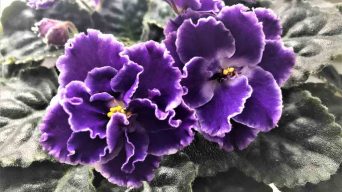African Violet flowers can die from over or underwatering, harsh sunlight, nutrient imbalance, dim light, and dry air. Signs of a dying plant include flower loss, crown and stem rot, drooping leaves, wilting, and yellowing foliage. Revive the plant by adjusting watering, light, and soil conditions.
Watching your once-thriving African violet flowers wither and fade can be disheartening for any plant enthusiast. But fear not!
With some knowledge, care, and attention, you can breathe new life into your dying African violet and restore it to its former glory.
This guide will discuss the common causes of African violet demise and provide practical tips on reviving these delicate beauties.
Understanding The Common Causes Of African Violet Flowers Dying
Thanks to their delicate and colorful blooms, African violets are a popular choice for indoor gardening enthusiasts.
However, despite their beauty, these flowers can be susceptible to various environmental factors that can cause them to wilt and die.
Understanding the common causes of African violet flowers dying is essential for keeping these plants healthy and thriving.
Here we will explore the potential culprits behind this frustrating phenomenon, from temperature fluctuations to pest infestations.
Temperature Changes
One of the primary factors that can impact the health and vitality of your African Violet is sudden temperature fluctuations.
These delicate flowering plants are native to East Africa and have adapted to thrive in a relatively stable environment with temperatures ranging between 65 to 80° F (18 to 27° C).
To maintain the well-being of your African Violets, it’s crucial to provide them with a consistent temperature throughout the day and night.
Ensure their growing area doesn’t experience drafts or abrupt changes – this could be due to an open window or being placed too close to heating or cooling vents.
For instance, imagine you live in an area with rapidly changing weather conditions; consider placing your plant in a spot less affected by these shifts – like an interior room or away from large windows – and monitor its response closely.
Over Or Underwatering
Over or underwatering is a common issue that can quickly lead to the demise of your beloved African violet.
Both extremes create an unhealthy environment for the plant, resulting in root rot, wilted leaves, and, ultimately, dying flowers.
For instance, if you notice that your african violet leaves are turning yellow and soft at the edges.
At the same time, the soil surface remains damp for prolonged periods, which likely indicates overwatering.
On the other hand, if you observe wrinkled lower leaves accompanied by dry soil and a lack of new growth, it’s time to dial up your watering frequency.
In both cases tweaking your watering technique could be essential – consider adopting a wick watering system that has proven incredibly effective in maintaining optimal moisture levels for thriving African violets without exposing them to excess water or nutrient deficiencies.
Improper Lighting
One of the culprits behind your African violet flowers dying could be improper lighting.
As a houseplant, these delicate flowering plants require bright indirect light to thrive – direct sunlight can do more harm than good by scorching their leaves and causing stress that leads to flower loss.
To ensure your plant gets proper lighting, place it near an east- or west-facing window with sheer curtains to diffuse the sun’s harsh rays.
If natural sunlight isn’t available or insufficient, consider using an artificial grow light specifically designed for indoor plants like yours.
Remember that keeping your African violet’s home well-lit but away from direct sunlight will make all the difference in its health and blooming potential.
Pests And Diseases
African violets are susceptible to various pests and diseases that can cause them to wilt, drop leaves, or stop flowering altogether.
Tiny white specks on the leaves indicate spider mites, while black bugs may signal aphids or mealybugs.
Cyclamen mites can cause distorted growth or stunt plant development entirely.
African violet plants can also suffer from fungal infections like root rot or rust.
It’s essential to watch for these common issues and address them immediately using appropriate treatments like insecticides, fungicides, or neem oil sprays.
How To Rescue Dying African Violet Flowers
If you’re an African violet enthusiast, you know how disheartening it can be to watch your precious plant wither away.
However, fear not!
With a little TLC and simple adjustments to your care routine, you can rescue your dying African violet flowers and return them to their former glory.
Below we’ll take you through the steps you need to take to trim off wilted or blackened leaves, adjust your watering and fertilizing routines, repot your plant, and address any pest or disease issues affecting it.
Trim Off Wilted Or Blackened Leaves
To rescue your dying African violet flowers, one of the first steps is trimming off wilted or blackened leaves.
This will not only improve the appearance of your plant but also prevent diseases from spreading further. Here’s how to do it properly:
- Identify which leaves are dead or dying by looking for discoloration, wilting, or spotting.
- Use a clean and sharp pair of scissors or pruning shears to cut the affected leaves as close to the base as possible.
- Dispose of the trimmed leaves, as they may still carry the disease or pests that caused them to die.
- Depending on how many leaves need trimming, consider reducing watering frequency until new growth appears.
Adjust Watering And Fertilizing Routines
Proper watering and fertilizing are critical to the health of your African violet flowers.
Here are some tips to help you adjust your routines and rescue your dying plants:
- Watering: African violets should be watered thoroughly but not excessively. Avoid using cold water or letting the plant sit in standing water for extended periods, which can cause root rot. Bottom watering is recommended, where the pot is placed in a saucer of water and allowed to absorb moisture through the drainage holes until the topsoil is moist.
- Fertilizing: Use a high-quality fertilizer designed specifically for African violets, following the instructions on the package carefully. Over-fertilization can lead to burnt roots and foliage, while under-fertilization can stunt growth and blooming.
- Adjustments: Observe how your plants respond to the current watering and fertilizing routine, making adjustments based on their growth patterns and symptoms, such as wilting or yellowing leaves. Keep track of watering frequency, amount of fertilizer used, and any changes made to determine what works best for your specific plants.
Remember that every African violet has unique needs.
Finding the perfect balance between watering and fertilizing may take trial and error, leading to healthy growth and beautiful blooms.
Repotting
Repotting your African violet can help revive it and promote healthy growth.
Here are the steps to follow:
- Choose a pot one size larger than your current one, with adequate drainage holes.
- Prepare a fresh potting mix of equal parts vermiculite, perlite, and peat moss or coconut coir.
- Carefully remove the plant from its old pot, being gentle not to damage the roots.
- Remove any dead or damaged leaves or flowers.
- Add enough new potting mix to the bottom of the new pot so that when you place your plant on top, the soil surface is no lower than the rim of the old pot.
- Place your plant in the center of the new pot and add more fresh soil around it until it is level with the top of the root ball.
- Firmly press down on the soil to eliminate air pockets and water thoroughly.
Addressing Pest And Disease Issues
Dealing with pests and diseases is crucial to keeping your African violet plants healthy.
Common plant issues include spider mites, mealybugs, aphids, botrytis, and powdery mildew.
Here are some steps you can take to address these problems:
- Inspect plants for signs of pests or diseases regularly.
- Quarantine any infected plants away from healthy ones to prevent the spread.
- Treat with appropriate pesticides or fungicides as necessary, following product instructions carefully.
- Avoid overwatering and provide adequate ventilation to prevent fungal growth.
- Keep leaves dry and remove any damaged or infected foliage promptly.
- Maintain good hygiene by cleaning tools, pots, and surfaces regularly.
Caring For Your African Violet Flowers
Proper care and maintenance are crucial for the healthy growth of African violet flowers.
Neglecting their needs can lead to issues like pest infestations and stunted growth.
Here we’ll discuss the essential elements of African violet care, including watering, lighting, and fertilization.
Following these guidelines, you can ensure that your African violet blooms flourish and remain vibrant and healthy for years.
Proper Watering
Proper watering is critical to keeping your African Violet flowers healthy.
Overwatering can lead to root or crown rot, while underwatering stunts growth and leads to wilting.
To avoid overwatering, ensure your soil mixture is well-draining and doesn’t retain water for too long.
Letting the soil dry out slightly between waterings is recommended.
It’s important to note that humidity levels, temperature changes, and pot size may affect how much water your African Violet needs.
Remember that proper care of your plant will lead to new growth on healthy leaves at the base of the plant rather than simply watering a wilted leaf back into health.
Correct Lighting
Proper lighting is crucial to ensure your African Violet flowers thrive.
Direct sunlight can scorch the leaves and cause dehydration, while insufficient light will result in stunted growth and no blooms.
Look at its foliage to determine if your plant is getting the right amount of light.
The leaves should be a bright green color with a horizontal flat wheel shape growing outwards.
It indicates that the plant needs more brightness if they start reaching upward.
Remember to rotate your plant occasionally to ensure all sides get equal exposure to sunlight, avoiding lopsided growth patterns.
Adequate Fertilizing
Another crucial aspect of caring for African violet flowers is providing them with adequate fertilization.
Fertilizers provide essential nutrients that help the plant maintain its health and promote growth.
To ensure that your African violets receive proper nourishment, apply a balanced houseplant fertilizer every other week during their growing season.
It’s worth noting that Miracle Grow African Violet Potting Soil already has added fertilizer, so additional fertilization may not be necessary right away.
However, as your plant grows and blooms, it will benefit from regular fertilizing to help it thrive.
Final Thoughts
Saving your dying African violet flowers is not difficult with the proper knowledge and care.
Understanding the common causes of flower loss, such as temperature changes, improper lighting, and pests or diseases, is vital to rescue your plant.
You can revive your plant’s health by adjusting watering, fertilizing, and repotting routines and addressing pest issues.
Remember to provide proper care by giving bright indirect light and adequate water and fertilizer while avoiding common stressors such as cold drafts or direct sunlight.







